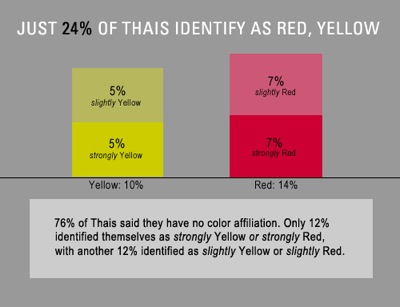Below is a guest post that appeared yesterday on the Bangkok Pundit blog, which is part of the Asian Correspondent site. Here is a link to the original post.

By Newley Purnell
The red shirt protests, as we know, came to a dramatic and bloody conclusion on May 19, when security forces dispersed anti-government demonstrators from central Bangkok. Throughout the nine weeks of protests, nearly 90 people were killed.
But red shirt supporters, it might be surprising to know, are still gathering in Bangkok today — albeit on a much smaller scale.
Yesterday I visited the headquarters of the opposition Pheu Thai party, located in a building along Rama IV road. As tomorrow’s by-election approaches, with a Pheu Thai candidate squaring off against a Democrat rival, I wanted to see what the mood was like.
In addition, I wanted to catch a glimpse of a red shirt exhibition that has been created to mark the two month anniversary of the crackdown. The exhibit, which runs through tomorrow, is designed to highlight the reds’ grievances with the government. Here is a gallery with 14 images of the exhibit.
Columns on the outside of the building were draped in black, and inside there were political banners, photos of injured and dead protesters, and a mannequin dressed as a red shirt protester aiming a slingshot at a figure dressed as a soldier, armed with a rifle, on a balcony above.
A red shirt supporter, dressed as a soldier in camouflage and carrying a plastic toy rifle, walked around chatting with visitors. And there was music — interspersed with the sounds of gunfire. There was even a smoke machine in operation.
Replica weapons and ammunitions were on display, as were bamboo poles of the type used to construct the Silom barricade. Some walls were even draped in plastic black netting, which brought to mind the fabric that had been stretched across the stage at Rajaprasong.
Red T-shirts bearing exiled Prime Minister Thaksin Shinawatra’s face were on sale outside the building. Coffee and cookies were available, and red shirt supporters of all ages — clothed in their signature “Truth Today” gear — ambled about, posing for photos in front of the various presentations. A small boy ran around with a red bandana on his head.
According to a handout, the exhibit is called “Seven Days and Seven Agonies of the Thai people.” Various “zones” reflect “insidious rhetoric and an application of double standards,” while another zone — complete with a sample water dispensing machine said to be sold to villages by the government at an unfair markup — alleges government corruption.
“We want to tell the truth about the events of 19 May and 10 April,” Natawud Duangnil, who was staffing the exhibition, told me. “Every story has been twisted by the government and the media, which is controlled by the government.”
He said that it was unfair to blame the arson attacks, like the one that occurred at the CentralWorld shopping center, on the red shirts. He argued that the fires there began after soldiers had control of the Rajaprasong area, and that troops wouldn’t allow fire fighters to reach the mall to put out the fire.
I told him that many people with whom I’ve spoken are angry at the red shirts for claiming to be non-violent demonstrators — but then fighting with, or harboring, those with guns.
“Thai society has cracked already,” he said. “If the red shirts had guns — if it’s true — then it’s not right. But look at the pictures of the people who died,” he said, gesturing at the exhibit. “They were unarmed.”
I asked Natawud if he is afraid that the government will close the exhibition. “We don’t care because we have a right to do this as a political party,” he said. “Everyone has rights.”
Some people say that the red shirts don’t really want democracy, I said, and that they’re merely mis-guided mercenaries fighting for Thaksin. “That’s just a story from their media,” he said. “Yes, we’re pro-Thaksin. But we don’t care if he comes back or not.”
What’s next for the red shirt movement? “We’re upset. We’re sad. We’re angry,” he said. “I can’t deny that. Look at the peoples’ faces,” he said, referring to the visitors. “They cry. But in our minds, we don’t want anything more than justice.”
According to this Nation story, Prime Minister Abhisit Vejjajiva has said the exhibition should not bend the truth in order to exacerbate divisions among Thai society. The article also notes that Pheu Thai says they’ll take the exhibition on the road to other provinces.
Meanwhile, a story from NNT/Thailand Public Relations Department says that ambassadors from “Germany, Hungary, China, Cambodia, the Netherlands, the UK, India, Australia, and many others” have visited the exhibit.




